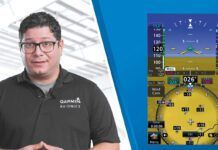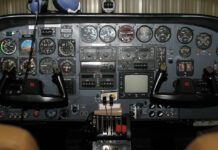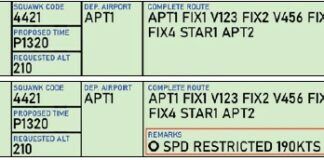Fuel is the single biggest variable expense for aircraft operators. What if you could reduce your cost by 30 percent? In addition to being expensive, gas is heavy. New airplanes containing the creature comforts of a luxury car have terrible useful loads with full tanks. Maybe three normal adults can fit into a typical four-place airplane before being overweight. Add baggage, golf clubs, or fishing poles and you’re leaving gas behind. Trading gas for weight can severely limit range, one of the consequences of traveling by plane.
All of these issues can be addressed with a little knowledge. As an example, we’ll take a trip from Falcon Field, GA—just south of Atlanta—to Dare County, NC to visit Kitty Hawk. We’ll fly a Cessna 172N, Beechcraft E33A Bonanza and our editor’s Cessna 340A.
Speed
One way of measuring fuel efficiency is specific range. Specific range is mileage per gallon of gas. We often use it when discussing cars—how many miles per gallon does your car get? The higher the specific range the more efficiently the fuel is being used.
When the Cessna 172N is traveling at 116 knots burning 8.4 GPH, the specific range is 13.8 MPG (nautical, of course). In airplanes, specific range is a function of drag and engine-propeller efficiency.
From a purely aerodynamic perspective, best specific range is achieved at minimum drag for the required lift, or (L/D)max . The speed isn’t listed in the POH, but a near-equivalent is best glide. Best glide is (L/D)max for a given configuration: in the 172 and Bonanza, this includes a windmilling prop creating a lot of extra drag. As drag increases, the speed for (L/D)max decreases. Best glide for the 172 is 65 knots. Add a couple of knots for a working engine and (L/D)max speed is 67.
For airplanes with props, we need to add in propeller efficiency. Propellers are designed to work best at certain airspeeds. Since flying at best glide doesn’t boost sales, most propellers are tuned for higher cruise speeds.
Best specific range for a propeller aircraft is the speed that results in the lowest amount of drag and highest prop efficiency. Thankfully, we all already know this speed, Vy. Slowing cruise speeds towards Vy significantly improves specific range.
Slowing the 172 from 116 to 94 KTAS improves specific range by 21 percent, to 16.8 MPG. The Bonanza sees a 16 percent improvement and the Cessna 340 turns in a massive 27 percent increase in efficiency by slowing to the bottom of the cruise performance table.
Going to Kitty Hawk, slowing down increases options. The trip is 495 miles. Neither the 172 nor Bonanza can make it non-stop at 75 percent power. By using 45 percent power, both aircraft can, with IFR reserves and gas to spare. If our esteemed editor was doing this trip in his 340, he would save 28 gallons, or about $150.
Altitude
Total drag is the combination of induced and parasitic drag. Faster than (L/D)max, the biggest influence comes from parasitic drag—friction of the airplane moving through the air. This type of drag is logarithmically sensitive to increased pressure, that is, indicated airspeed.
As altitude increases, air density decreases. As a result, a higher true airspeed is achieved for a given indicated airspeed. As a rule of thumb, true airspeed is two percent more than calibrated airspeed for every thousand feet up.
Let’s look at the 172. Seventy-five percent power at 2000 feet results in a specific range of 13.8 MPG. (Fuel flow is power. Similar fuel flows closely equate to the same power. You can think of a power setting as a fuel flow.) By climbing to 6000 feet, the specific range increases to 14.5 MPG, a 5 percent improvement. The turbocharged 340 sees a 15 percent improvement climbing from 5000 to 20,000 feet.
Climbing costs gas and time. For a short climb, the 172 burns 5.5 MPG. The higher fuel burn during a climb must be offset by lower cruise fuel flow or efficiencies in descent to get any savings overall.
If planning a constant power cruise, say at 75 percent, it is almost impossible to make up the fuel used to climb. For example, on our trip in the C172, we’ll burn an additional 0.8 gallons by climbing to 9000 feet versus 3000. In the C340, it is about a wash. This is significant because the 340 has a time, fuel, and distance to descent chart allowing accurate descent planning, information not found in the C172 and Bonanza, POH.
Savings from climbing result from a constant airspeed cruise compared with constant power. A rule of thumb for the most efficient cruise altitude for shorter flights is multiplying trip distance by 50 to 100, depending on overall distance and the aircraft. If we cruise at 110 KTAS in the C172, we’ll save three gallons (10 percent), by flying high on our trip. Since parasitic drag increases dramatically with speed, the savings of climbing are most pronounced when flying fast. The slower one flies, the less savings. Flying our trip at 100 KTAS at 9000 feet or 3000 feet would be a wash in the C172.
The rule of thumb multiplier decreases for longer distances. Minimum altitudes, regulatory restrictions, performance, and physiology all factor into an optimum altitude. For our trip to Kitty Hawk, it is worthwhile to go high, 9000 feet for the Bonanza and Skyhawk avoiding oxygen, and FL250 in the 340.
Other Factors
Even though speed and altitude have the most influence on fuel economy, other factors still play a roll. Aircraft weight increases gas required for all phases of flight. Extra weight also increases induced drag because of the higher angle of attack required to lift that weight. However, at speeds above (L/D)max, induced drag is fairly insignificant compared to parasitic drag.
Aircraft design can also be a limiting factor. John-Paul Townsend of General Aviation Modifications Inc. (the makers of tuned fuel injectors allowing lean-of-peak operations) notes that some Continental engines require a minimum 2300 RPM for cruise. Additionally, cowlings are designed to work efficiently through a set range of speeds. Induced drag may increase significantly when flying slower than lowest speed in the cruise table.
The environment impacts fuel economy. Icing and turbulence determine safe and comfortable altitudes. Wind also affects us since we are ultimately interested in ground miles not sky miles. Often picking a favorable altitude is more important than climbing. The rule of thumb is to fly fast into a headwind and slow with a tailwind. This is a good idea, but only results in savings with winds over 20 knots for the C172.
Go Fast, Save Cash
While the bill from the fuel pump is typically the largest variable expense, on occasion it pays to fly fast. This occurs when the savings of flying slow are offset by other variable costs. Flying with an instructor worth his/her weight still costs more than the fuel burned, so fly fast. On our trip, cruising at 75 percent power results in just over 4 hours of time, saving five gallons of gas at 45 percent power extends the flight by an hour. At $6 per gallon, the hour saves thirty bucks, but if flying with an instructor who charges $40 per hour, we just spent $40 to save $30.
Determining whether it is cheaper to fly fast is a function of fuel price and variable cost. If gas prices drop to $3, it is cheaper to fly fast in almost every situation. On the other hand, if prices reach $10, flying slow is the way to go.
Determining variable cost for general aviation is problematic. When I spoke to Brant Harrison of Audries Aircraft Analysis, he pointed out that it is impossible to accurately estimate a generalized variable cost because underutilization (fixed costs) drives most GA maintenance expenses.
An individual owner or club can determine more specific numbers. The key is understanding variable versus fixed cost. Variable costs are directly associated with the operation of the aircraft. Don’t move the airplane all year and there are no variable costs. Variable costs typically are engine reserve, oil changes (assuming you fly enough to need a change on an hour basis), 100-hour inspections if necessary, and operating time-based ADs. Once variable expenses are determined, you can plug that number into the following formula to determine if you should fly fast:
((FuelFlowGPH FuelGallonCost) + VariableCosts) TAS equals your cost per mile (no wind). Fill in the variables using your parameters for the selected scenario (high, low, fast, slow) and compare with other scenarios.
For the Bonanza at 4000 feet (the same altitude must be used for a direct comparison of speed), high speed cruise burns 13.3 GPH at 159 KTAS and low speed cruise sips 9.6 GPH at 134 KTAS. If variable costs are $30 per hour, every mile costs an additional 3.68 cents to fly fast (using $6 per gallon for gas).
Placing my favorite CFI in the right seat for $40 per hour (increasing variable cost to $70 per hour), results in a savings of 1.01 cents per mile to fly fast. That difference probably doesn’t matter, but in other scenarios the differences can be significant.
Bringing it home
Maverick had a need for speed in “Top Gun.” Lucky for him he filled up using the government’s credit card. Unless you fly on the government’s dime, have an Arabian prince you call “Uncle,” or pump black gold in your back yard, slowing down and flying high can save significant cash. Additionally, these strategies can improve your range.
Flying high and going slow results in a whopping 31 percent fuel savings in the Cessna 340. The Bonanza and Cessna 172 have over a 20 percent fuel savings. Now, before we get emails, you cannot actually fly IFR between FFC and MQI at 3000, or even 5000 feet. But, the data presented here highlights the possible savings. Also note, that both the 172 and Bo’ couldn’t get there non-stop if low and fast.
So what do I do? I plan my flights a little bit above the bottom of the cruise performance chart, preferably a nice round number. That way, if I get thrown a curve ball I can slow to the bottom of the chart increasing range and endurance. I now have flexibility if plans change and can still carry that extra last minute bag.
Jordan Miller flies and drives slow, saving dough wherever he goes—except, of course, when he’s late or on the leg home.
A little pet-peeve of mine is pilots talking about getting “on the step.” It demonstrates they don’t understand aerodynamics or boating. Hydroplane boats started to appear in the 1920’s. These boats took advantage of physics. Water and air are both fluids but with different properties. The resistance to an object moving through a fluid is a function of mass. Since water has a much higher mass than air, moving an object through water takes more energy than moving the same object through air at the same speed. Take your hand and run it through water then air for a dramatic illustration of the difference.
Hydroplanes, and other stepped hull designs (like floats on seaplanes), work by forcing air under the boat thereby reducing the area in contact with water. Hydroplane racers are flying for all practical purposes.
Speed is required to hydroplane or get “on step” because air needs to be forced under the hull. At a certain speed enough air is forced under the hull to raise a portion out of the water, significantly reducing drag.
Airplanes and submarines don’t do this. Airplanes fly through the same fluid, air, and any increased efficiencies gained by the propeller as speed increases is counteracted by drag above Vy.
Being “on step” is a perceptual fallacy a wing does not understand. Cruising around pointed toward the sky doesn’t feel right as a pilot. Speeding up to a flatter pitch just feels better. This is due to aircraft design. The angle of incident is the angle at which the wings are attached to the airplane. Generally, this is designed to provide a level deck at planned cruise airspeeds. It feels more efficient.
So, no more of this “on the step” business. I can’t take it much longer. —JM
One of the most important tools for managing fuel and range is the fuel gauge. But, general aviation aircraft fuel gauges have a reputation for seldom working correctly. Students are taught that the best fuel gauge is a timer and that fuel calculations are the way to go.
I certainly support using time and fuel burn rates for planning and even as an adjunct to the gauge indication. But, there’s nothing in the regulations that says it’s OK for a fuel gauge not to work properly.
Let’s look at that a moment. Part 23 of the regulations deals with aircraft certification standards and 23.1337(b) specifically requires a means to tell the pilot(s) the amount of usable fuel remaining. So, you’ve got to have a fuel quantity indicator, be it a bobbing cork or a sophisticated temperature-compensated measurement system.
You commonly hear that an aircraft fuel gauge need only read accurately when the tank is empty. That misconception probably comes from 23.1337(b)(1) that says the indicator must read zero when the only fuel remaining is unusable. The purpose of this, of course, is to stipulate that the indicator read usable fuel only and ignore unusable fuel—a reasonable requirement.
Finally, 91.205, the regulation that tells us the minimum equipment that must be installed, specifies that there be a fuel indicator. You should wisely conclude from this that the gauge must be working.
The regulations do not, however, stipulate an accuracy requirement for the fuel indicator. Does this mean that the gauge can read full when there’s less than a quarter tank left? Not likely, because the regulations that speak to the requirement of a fuel indicator also have language saying that it must indicate the quantity of usable fuel remaining.
You could probably justify an error of 10 to maybe even 15 percent, depending on the size of your fuel tanks, but a gross error in the fuel indication certainly cannot be claimed to provide the pilot with an indication of the amount of fuel available.
So, if your mechanic claims, as many do, that no fuel gauge is accurate and that it only needs to indicate empty accurately, challenge that and ask for a reference that an inaccurate gauge is acceptable. After all, if you want to get the most utility out of your aircraft and you’re planning to use most of the fuel available, wouldn’t you like to have a good indication of how much actually remains? —FB




